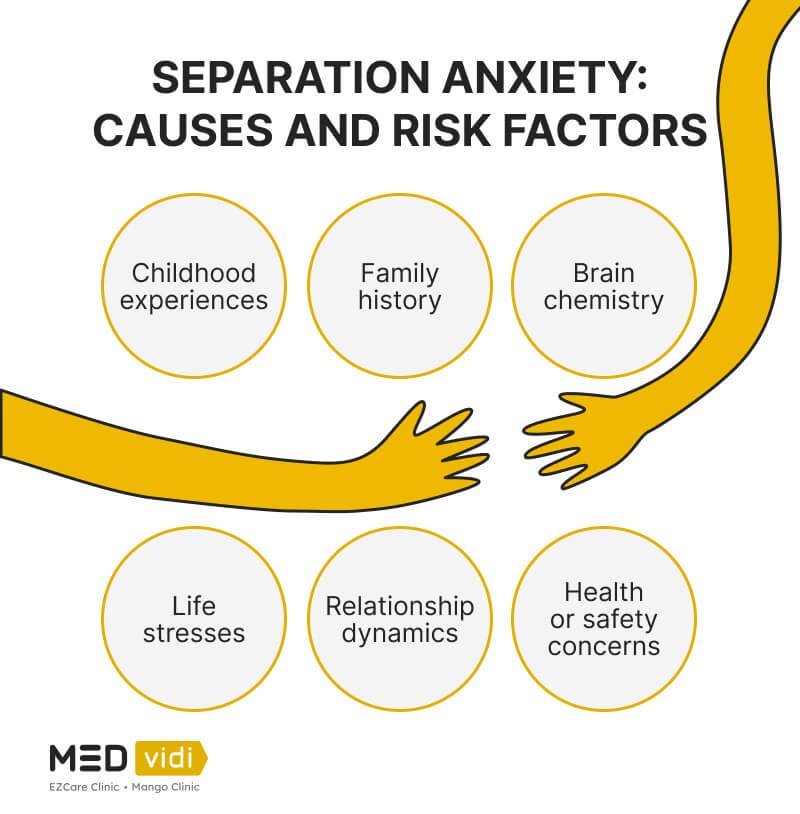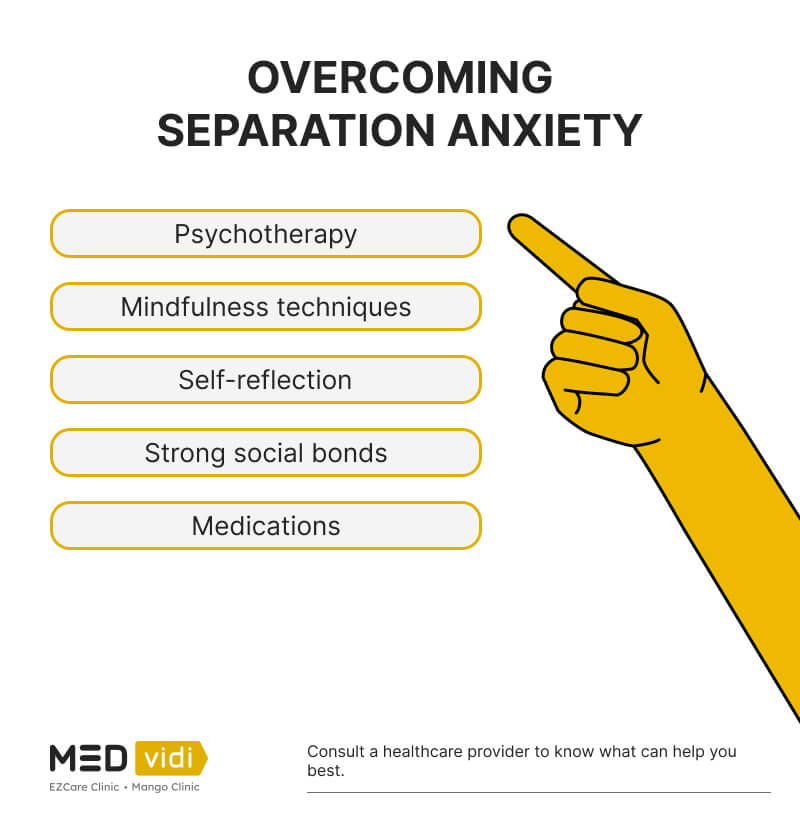Separation anxiety is often associated with tearful toddlers or kids on their first day of school. However, this emotional response isn’t confined to childhood. Recent
Understanding the prevalence and impact of separation anxiety in the adult population is crucial. In another
Looking to stop separation anxiety? Click the button below to book your appointment.
What Is Separation Anxiety Disorder and Its Main Domains?
Separation anxiety disorder, commonly referred to as SAD, is a psychological condition characterized by excessive fear or anxiety about separating from those to whom you are attached. Stress caused by separation anxiety can be triggered by babies, parents, partners, and other people and conditions.
Separation anxiety can also result from having to shift your workplace or move far from your friends and family. Below, let’s focus on the main themes of separation anxiety disorder as depicted in adulthood experiences.
Adjustment Disorder vs Separation Anxiety
Also known as stress response syndrome, adjustment disorder is a temporary condition describing a state where you’re unable to cope with a particular source of stress. This could include any significant change in your life: the loss of a loved one, or a particularly stressful life event.
Adults can also experience adjustment disorder anxiety. It can be triggered by an abrupt change in life, such as relocating far away for a new job. Being away from your residence, family, friends, and support system can worsen the adjustment disorder anxiety experience.
Separation Anxiety from Your Baby
Parents, especially new mothers, are also prone to separation anxiety disorder. This condition is also known as
During child delivery, women experience a decrease in progesterone and estrogen hormones. This can leave them susceptible to experiencing stress which then results in overwhelming feelings of panic and fear. Sleep deprivation from newborn care can heighten these feelings and further aggravate the situation.
Separation Anxiety from Partners
Missing your partner is quite common and normal. When you’re away from them, it’s normal to long for their return and feel uneasy and lonely without their presence. However, when the worry, nervousness, and emotional turmoil overwhelm you to the point of disrupting your daily life and routine, you could be experiencing separation anxiety from your partner.
These feelings of uneasiness are more than just missing your partner. In many cases, they involve a deeper apprehension that you’re unable to service without them. Separation anxiety from your partner also convinces you they’ll most likely get hurt if you’re not around them or that you may lose them forever.
Separation Anxiety from Pets
Pets have been known to experience separation anxiety. However, it’s also common for pet owners to experience separation anxiety disorder if they have to be away from their pets. You can tell if you’re experiencing pet separation anxiety if you display the following signs:
- You have an irrational fear of an extraordinary circumstance happening to your pet. This could range from your pet harming themselves in your absence to them getting kidnapped or killed.
- You regularly find unjustifiable excuses to stay with your pets and avoid going to work, spending time with your family and friends, and other social events. You could also insist that your pet comes along no matter how inappropriate the scene or environment may be.
- You find it difficult to maintain attention and focus on your work and other activities as you’re worried about your pets. This can result in poor performance and slacking at work.
What Are the Symptoms of Separation Anxiety Disorder in Adults?
Below are the most prevalent signs and symptoms associated with separation anxiety disorder (SAD). While this list below will give you an idea of how SAD may feel like, it’s essential to seek professional help instead of self-diagnosing. So, the common symptoms of adult separation disorder are:
- Increased anxiety when anticipating or experiencing separation from loved ones or home.
- Excessively worrying about losing your loved ones and any harm that could befall them. This may include fear of your loved ones getting sick, into an accident, injured, or dead.
- Persistently refusing to leave the house as a result of fearing separation from family.
- Excessive fear of being alone or being detached from your loved ones at home.
- Recurring nightmares involving separation from your primary family.
- Repeated experiences with physical symptoms when separated from prominent family figures. These physical symptoms may involve headaches, nausea, stomachache, and vomiting.
- Clinically substantial distress or impairment in academic, social, and occupational functions caused by the fear of separation.
The prevalence of three or more of the above-mentioned symptoms indicates
Dealing with separation anxiety? Let our mental health experts help you understand your symptoms and guide you on the path to fixing separation anxiety.

What Can Cause Separation Anxiety Disorder in Adults?
Separation anxiety disorder is strongly connected to personal experiences, so its causes vary from one person to another. However, there are common patterns and factors, such as:
- Childhood experiences. Traumatic events or separations during formative years.
- Brain chemistry. Imbalances or abnormalities in neurotransmitters or brain structures associated with anxiety and fear.
- Life events. Significant transitions such as moving to a new city, experiencing the death of a loved one, or the end of a significant relationship.
- Relationship dynamics. Overly enmeshed or codependent relationships create a deep reliance on another person for emotional well-being.
- Past traumas. Experiences of abandonment, betrayal, or other traumas in adulthood can set the stage for heightened anxiety surrounding separations.
- Physical health conditions. Certain medical conditions, especially those related to brain function or hormone imbalances, might directly induce anxiety symptoms.
What Are the Risk Factors?
While the precise cause of SAD is not always clear, several risk factors can increase the likelihood of its development. These include:
- Family history. Children of parents with anxiety disorders or other mental health conditions might be more prone to develop anxiety disorders themselves, including SAD.
- Life stresses. Major life changes or stressful events, such as a significant loss, parental divorce, moving to a new place, or traumatic incidents, can act as triggers for separation anxiety.
- Prolonged separation. Extended separation from a primary caregiver or loved one, especially in early childhood, can increase the risk of SAD. This includes situations like hospital stays, boarding school, or prolonged trips where the child is away from their parents.
- Overprotective or intrusive parenting. Children who’ve been raised by overprotective parents might not develop the necessary coping skills to handle separations, increasing the risk of SAD.
- Attachment issues. Problems in the parent-child attachment process, such as inconsistent caregiving or disruptions in early bonding, can contribute to separation anxiety.
- Health or safety concerns. Past illnesses or experiences that threatened a person’s sense of security can make them more sensitive to separations. Also, chronic illness, especially in childhood, can sometimes result in heightened dependency on caregivers, which can make separations more distressing.
- Personality. Children with a naturally timid or shy temperament might be more vulnerable to separation anxiety.
- Gender. While both genders can experience SAD, some
research[5] suggests that it may be more prevalent in females than in males.
What Does Extreme Adult Separation Disorder Result in?
Separation anxiety disorder and related stress can make life hard to lead a normal daily life. Moreover, SAD also impacts the people around you and those you care about. Chronic clinginess and attachment can be more than enough to take for spouses, parents, friends, or children. Therefore, an extreme separation anxiety disorder can affect all spheres of your life, including the social, marital, and personal aspects.
Separation anxiety disorder in adults can be an indicator of underlying mental health disorders. Here’s more information on its longitudinal effects.
Effects of SAD on Relationships
The consequences of separation anxiety often affect personal connections, including difficulty forming meaningful and stable romantic relationships. If you have SAD, you risk being in unhealthy relationships where the other party takes advantage of you because of your attachment issues.
In most cases, adult separation anxiety disorder is damaging both to the affected person and their partner. Being overly protective, possessive, and vigilant can harm the personal space and comfort of your partner. Consequently, this may result in unnecessary arguments, fights, and mental pressure on both parties.
Social and Personal Impairments
Separation anxiety in adults can affect social, personal, and professional areas in the following ways:
- Lack of initiative and low interest in housework.
- Lack of social interaction and engagement.
- Lack of interest in studying.
- Irritable and volatile mood swings.
- Inability to take responsibility.
- Extreme sensitivity.
- Decrease in work performance.
- Lack of focus on assigned tasks.
Effects of Parental SAD on Children
Parental separation anxiety affects the parents as much as the children. The effects of SAD on children can carry on even when they are grown. For instance, those who grew up with parents with separation anxiety are more likely to lack independence through adulthood.
Moreover, the children may develop rebellious and clingy tendencies as a coping mechanism. There’s also an increased chance the child will develop separation anxiety from the overprotective nature of their upbringing.
Effects of Separation Anxiety on Mental Health
When left untreated, a separation anxiety disorder can significantly affect your mood. It can also cause constant fear of abandonment and increase the likelihood of developing other mental health disorders like depression and anxiety. When experiencing a separation anxiety disorder, you’re also at a greater risk of developing personality disorders like borderline personality disorder and dependent personality disorder.
How Is Adult Separation Disorder Diagnosed?
Diagnosing adult separation anxiety disorder begins with a comprehensive interview, focusing on symptoms, their duration, and any events that could trigger them. This assessment is cross-referenced with the criteria for SAD outlined in the DSM-5 (Diagnostic and Statistical Manual of Mental Disorders, Fifth Edition), ensuring that symptoms persist for over six months and cause significant distress. Additionally, a thorough physical examination rules out medical conditions like thyroid problems, which could be contributing to the anxiety.
Mental health professionals further delve into the individual’s history of early life experiences, possible traumatic events, and previous mental health issues. They might also observe the patient’s behavior during potential separation scenarios and differentiate
Healthcare professionals at MEDvidi are here to support you and help you to get through separation anxiety. Talk to them today!

Treatment Options for Adult Separation Anxiety Disorder
If you suspect you’re developing or having a separation anxiety disorder, consider seeking professional help. Only a qualified professional can help you to overcome separation anxiety. They will develop a personal online anxiety treatment plan that may include medications and non-medication treatment.
Psychotherapy
Different types of psychotherapy can help you to work through separation anxiety:
- Cognitive-behavioral therapy (CBT). This form of therapy aids in identifying negative thought patterns and behaviors related to separation. It helps to challenge these thoughts and develop healthier coping strategies.
- Dialectical behavioral therapy (DBT). Originating from CBT, DBT focuses on acceptance and change. It is particularly effective for individuals with severe emotional reactions.
- Group therapy. Being in a group setting allows individuals to share feelings and experiences. This mutual support system helps them realize they aren’t alone in their struggles.
- Family therapy. Involving family members in therapy sessions can promote understanding and create a supportive environment, especially since SAD can impact familial dynamics.
Medication Treatment
While no drug is FDA-approved specifically for SAD, several classes of medications can be effective:
- Antidepressants. Selective serotonin reuptake inhibitors (SSRIs) like Prozac (fluoxetine) or Zoloft (sertraline) and serotonin–norepinephrine reuptake inhibitors (SNRIs) like Effexor (venlafaxine) and Cymbalta (duloxetine) can be beneficial.
- Anti-anxiety medications. Benzodiazepines, such as Valium (diazepam), Ativan (lorazepam), or Xanax (alprazolam), can offer short-term relief but are generally used with caution due to concerns about dependence and potential side effects.
- Beta-blockers. These medications can help manage some of the physical symptoms of anxiety. Some common examples of beta-blockers include Lopressor (metoprolol), Tenormin (atenolol), Inderal (propranolol), and Carvedilol (carvedilol).
How to Prevent Separation Anxiety Disorder in Adults?
If you’re only experiencing mild SAD symptoms, your healthcare provider might first recommend psychotherapy and self-help techniques instead of medication to control separation anxiety. However, if the symptoms worsen, it’s advised to seek professional help for more assistance. Below are several practical and effective tips for separation anxiety management.
Tip #1. Practice Mindfulness
Anxiety feeds on your fears and perceived threats. Whenever you focus on what you’re afraid of, you give anxiety an opportunity to overwhelm you. To get over separation anxiety, practice mindfulness techniques to help you focus on the here and now. These techniques also keep your mind from spiraling out of control and keep you grounded.
Tip #2. Use Transitional Objects
Transitional objects are tangible items that represent a person or relationship you hold dear. By keeping these objects with you, you’ll feel connected and closer to the person. For example, you could have a friendship bracelet and wear it whenever you feel anxious. It may help you calm down even though you are not physically close.
Tip #3. Analyze Disturbing Thoughts
This is a practice where you actively separate thoughts that make you feel anxious. For instance, if you notice you’re feeling stressed about detaching from someone, you can choose to separate and classify these thoughts. Actively choose not to get stressed and analyze your reactions and presence in the current moment and environment.
Tip #4. Talk With Other People
Like many other mental disorders, SAD can make you feel like you’re alone. Whenever you think you’re getting overwhelming feelings, get someone to share what you’re going through. In most cases, the act of sharing alone can make you feel better. The other person could also offer advice to help you overcome these feelings.
Takeaway
Ultimately, it’s important to recognize that separation anxiety disorder bears similarities with other mental health conditions. Just like many of these other conditions, failing to seek help can result in catastrophic consequences. If left untreated, separation anxiety can wreak havoc on your daily life and relationships.
Fortunately, with early detection, there are steps you can undertake to handle separation anxiety and improve your quality of life. If you suspect you’re experiencing a separation anxiety disorder, try some of the abovementioned coping techniques and seek professional help.
Q&A
What are the three stages of separation anxiety?
Separation anxiety in adulthood is divided into these three stages:
- Protest—characterized by crying and resisting separation.
- Despair—marked by sadness and withdrawal in the absence of the attachment figure.
- Detachment—the person appears to adjust and may engage with other people, but often with less enthusiasm or trust.
What triggers separation anxiety?
Who is most likely to show signs of separation anxiety?
Infants and toddlers are most commonly associated with separation anxiety. But separation anxiety issues can also manifest in adults, particularly when faced with significant life changes or stressors.
Is separation anxiety normal in adults?
Yes, separation anxiety is normal in adults to some extent, especially during major life transitions or stressors. However, when it becomes chronic or severely impacts daily functioning, it may indicate a separation anxiety disorder. Consult a healthcare provider to work on separation anxiety and find effective coping strategies that can help you cope with separation anxiety.













